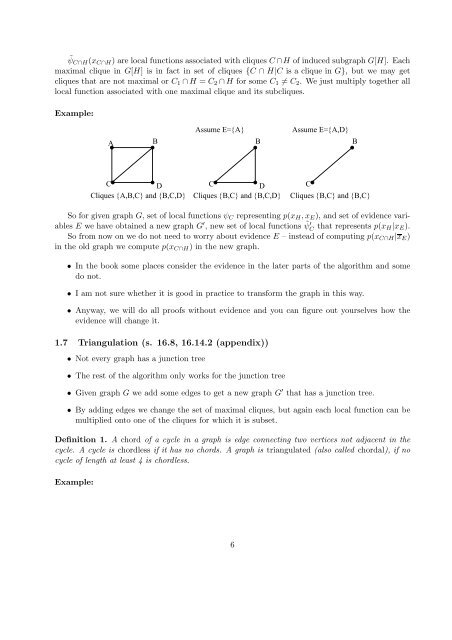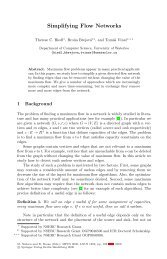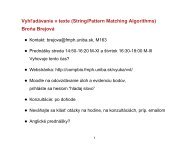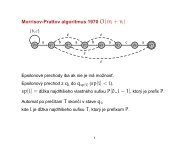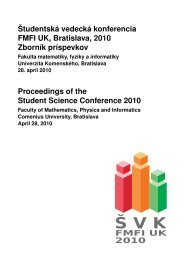1 The Junction Tree Algorithm (Hugin algorithm) Chapter 16(17 ...
1 The Junction Tree Algorithm (Hugin algorithm) Chapter 16(17 ...
1 The Junction Tree Algorithm (Hugin algorithm) Chapter 16(17 ...
You also want an ePaper? Increase the reach of your titles
YUMPU automatically turns print PDFs into web optimized ePapers that Google loves.
˜ψC∩H(xC∩H) are local functions associated with cliques C ∩H of induced subgraph G[H]. Each<br />
maximal clique in G[H] is in fact in set of cliques {C ∩ H|C is a clique in G}, but we may get<br />
cliques that are not maximal or C1 ∩ H = C2 ∩ H for some C1 = C2. We just multiply together all<br />
local function associated with one maximal clique and its subcliques.<br />
Example:<br />
A<br />
B<br />
Assume E={A}<br />
C<br />
D<br />
C<br />
D<br />
Cliques {A,B,C} and {B,C,D} Cliques {B,C} and {B,C,D}<br />
B<br />
Assume E={A,D}<br />
C<br />
B<br />
Cliques {B,C} and {B,C}<br />
So for given graph G, set of local functions ψC representing p(xH,xE), and set of evidence variables<br />
E we have obtained a new graph G ′ , new set of local functions ˜ ψ ′ C that represents p(xH|xE).<br />
So from now on we do not need to worry about evidence E – instead of computing p(xC∩H|xE)<br />
in the old graph we compute p(xC∩H) in the new graph.<br />
• In the book some places consider the evidence in the later parts of the <strong>algorithm</strong> and some<br />
do not.<br />
• I am not sure whether it is good in practice to transform the graph in this way.<br />
• Anyway, we will do all proofs without evidence and you can figure out yourselves how the<br />
evidence will change it.<br />
1.7 Triangulation (s. <strong>16</strong>.8, <strong>16</strong>.14.2 (appendix))<br />
• Not every graph has a junction tree<br />
• <strong>The</strong> rest of the <strong>algorithm</strong> only works for the junction tree<br />
• Given graph G we add some edges to get a new graph G ′ that has a junction tree.<br />
• By adding edges we change the set of maximal cliques, but again each local function can be<br />
multiplied onto one of the cliques for which it is subset.<br />
Definition 1. A chord of a cycle in a graph is edge connecting two vertices not adjacent in the<br />
cycle. A cycle is chordless if it has no chords. A graph is triangulated (also called chordal), if no<br />
cycle of length at least 4 is chordless.<br />
Example:<br />
6


